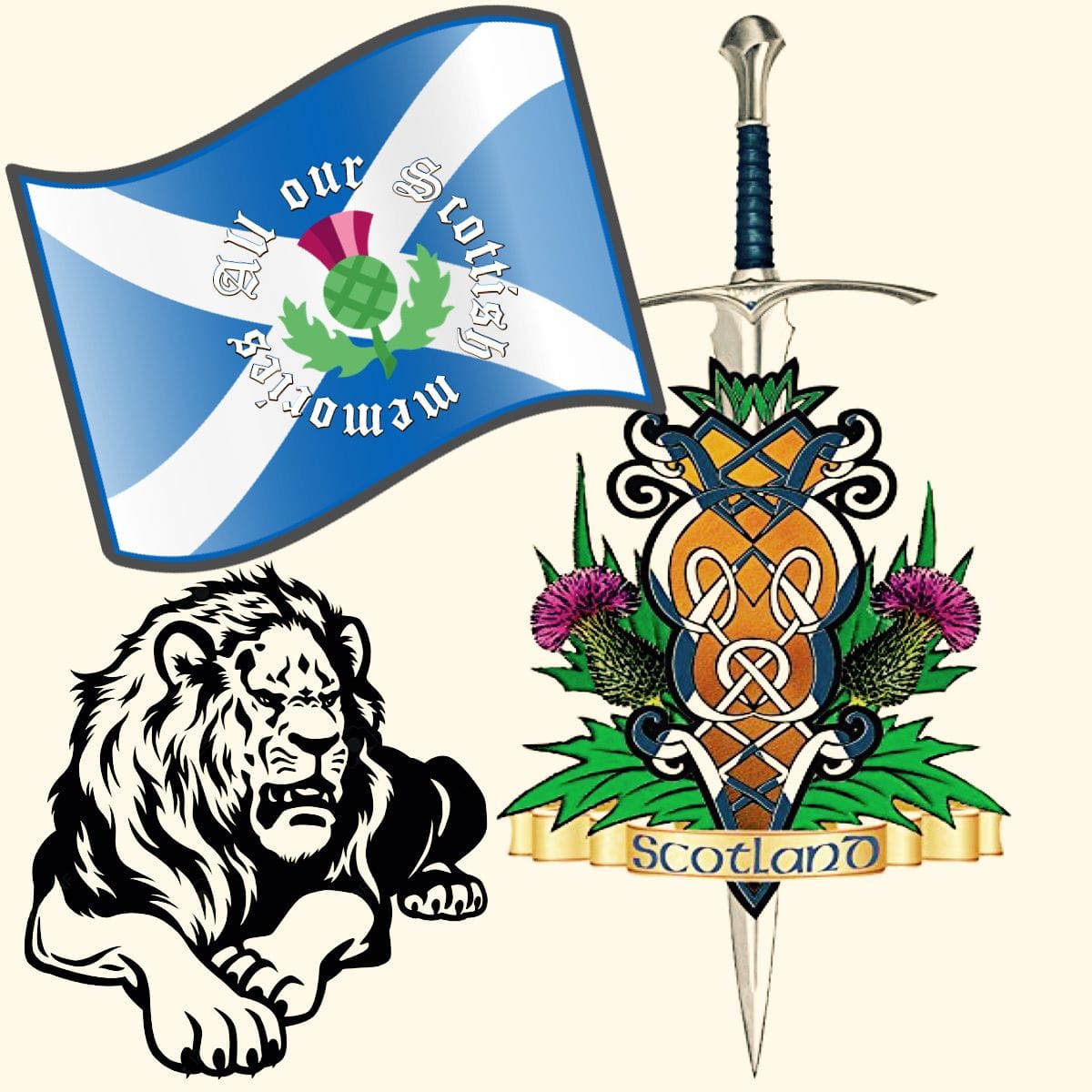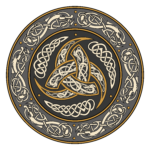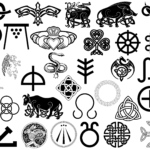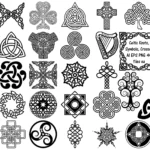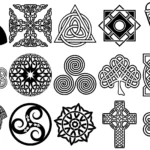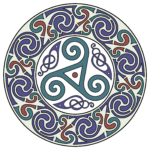Let’s dive into the world of Scottish symbols! From the intricate Celtic cross to the bold Saltire, each emblem tells a captivating story. These symbols are more than just pretty images; they are windows into Scotland’s rich heritage and unyielding spirit. Get ready to uncover the hidden meanings and fascinating tales behind these iconic symbols that have stood the test of time and continue to inspire and connect Scots around the globe.
Scottish Symbols: Embracing a Heritage Steeped in History and Culture
Scotland’s emblems are more than just flags and symbols; they’re threads that connect to the nation’s rich tapestry. Here’s a closer look at a few iconic symbols that capture the essence of this proud land:
The Saltire: A Cross with a Story
Imagine a pristine blue sky with a bold white cross cutting through it. That’s the Saltire, Scotland’s national flag. It’s a tribute to Saint Andrew, the patron saint of the nation, who is said to have been martyred on a cross shaped like an “X.”
The Unicorn: A Majestic Guardian
Picture a noble creature with a single horn protruding from its forehead – that’s the unicorn, Scotland’s national animal. It symbolizes purity, strength, and the indomitable spirit of the Scottish people. For centuries, it has stood as a proud symbol on the royal coat of arms.
The Thistle: A Prickly Statement of Resilience
With its vibrant purple bloom and spiky leaves, the thistle is a flower that embodies the resilience and loyalty of Scotland. It’s not a plant to be trifled with – its sharp thorns serve as a reminder that the Scottish people are a force to be reckoned with.
The Lion Rampant: A Symbol of Unwavering Spirit
Imagine a fierce lion standing tall, its mane flowing gracefully. That’s the lion rampant, a symbol of courage, dignity, and sovereignty. It’s been featured prominently on the royal banner of Scotland, representing the unwavering spirit of the nation.
Tartan: A Woven Tapestry of Diversity
The colorful patterns of tartan are like a mosaic that reflects the diversity and unity of Scotland. Each clan has its own unique pattern, a symbol of their heritage and a sense of belonging. It’s a reminder that even amidst differences, the people of Scotland are bound together by a common thread.
Haggis: A Hearty Symbol of Resourcefulness
Think of a hearty dish made from sheep’s pluck, oatmeal, and spices, and you have haggis, Scotland’s national dish. It’s a testament to the resourceful nature of the Scottish people, who have always made the most of what they have. A true symbol of simplicity and substance.
Table Summarizing Scottish Symbols
| Symbol | Meaning |
|---|---|
| Saltire | Martyrdom of Saint Andrew, Scotland’s patron saint |
| Unicorn | Purity, strength, nobility |
| Thistle | Resilience, loyalty |
| Lion Rampant | Courage, dignity, sovereignty |
| Tartan | Diversity and unity of Scottish clans |
| Haggis | Resourcefulness and simplicity |
Explore the fascinating world of ancient symbols and meanings to uncover the hidden messages and stories they convey. Dive into the rich history of Celtic symbols, unlocking the secrets of their intricate designs. Discover the ancient wisdom encoded in gaelic symbols, connecting you with the cultural heritage of our ancestors. Delve into the captivating realm of Irish Celtic symbols, revealing the enchanting legends they depict. Finally, immerse yourself in the captivating world of meaningful ancient symbols, unearthing their profound significance and timeless beauty.
How did the Saltire Become Scotland’s Iconic Flag?
Unravel the fascinating journey of the Saltire, Scotland’s beloved flag that has left an unforgettable mark on history. Its origins are traced back to an epic battle, and its symbolism has resonated with the Scottish people for centuries.
Legend has it that in 832 AD, King Angus II of the Picts faced the invading Angles near a small burn. As the battle raged, King Angus looked up to the sky and miraculously saw a white cross outlined against the blue clouds. Inspired by this divine vision, his army charged forward to a resounding victory. The white cross became a symbol of God’s favor and protection, and was later named the Saltire after its shape, resembling the diagonal cross on which Saint Andrew, Scotland’s patron saint, was martyred.
Over the centuries, the Saltire evolved from a battle banner to an official symbol of Scottish sovereignty. In 1385, King Robert II formally recognized it as Scotland’s national flag, and it has since been proudly flown by Scottish ships, castles, and armies.
The Saltire is more than just a symbol of national pride; it’s a testament to the courage and unity of the Scottish people. It has been flown by Scottish soldiers throughout history, representing their unwavering spirit and unwavering determination. Its blue background echoes the vast Scottish lochs, while the white cross stands as a beacon of hope, resilience, and the unwavering belief in their homeland.
Today, the Saltire remains one of the oldest national flags still in use today, a testament to its enduring legacy. It’s a symbol that transcends time and continues to inspire generations of Scots, both at home and abroad.
Scotland’s National Flag: Unveiling the Symbolism of the Saltire
Scotland’s flag, the Saltire, is an emblem of pride and unity for Scots around the world. It’s a symbol that embodies the nation’s history, faith, and spirit.
A Timeless Cross
The Saltire’s most prominent feature is its white cross. This cross, known as St. Andrew’s Cross, represents the patron saint of Scotland. Legend has it that in the 9th century, a king saw a white cross in the sky before a battle. Inspired, his army charged to victory. Ever since, the Saltire has been linked to St. Andrew and his enduring legacy.
A Blue Banner of Hope
The deep blue background of the Saltire is more than just a contrast to the white cross. It symbolizes the heavenly light and protection that has been bestowed upon the Scottish people. Blue has long been associated with hope, faith, and the unwavering spirit that has guided Scotland through countless challenges.
Key Takeaways
- The Saltire is the national flag of Scotland.
- It features St. Andrew’s Cross, symbolizing the nation’s patron saint.
- The blue background represents divine protection and hope.
- The Saltire has been flown as a battle flag and is a cherished symbol of Scottish identity.
Citation:
Scottish Symbols: How They Came to Symbolize Resilience and Determination
In Scotland, the mighty thistle stands tall as a symbol of the unwavering spirit that resides within the hearts of its people. Its prickly spines serve as a testament to the nation’s ability to overcome adversity, while its resilience mirrors the indomitable strength of the Scottish people. Whether near or far, the thistle unites Scots worldwide, fostering a profound sense of belonging and resilience that empowers them to face any challenge head-on.
The Saltire, with its striking blue and white stripes, is another powerful symbol of Scotland’s determination. The bold white cross against the cerulean backdrop epitomizes the fortitude and unwavering spirit that have guided the Scottish people throughout their rich history.
Delve into the ancient realms of the Celtic Cross, a seamless blend of Christian and pagan beliefs that embodies spiritual unity and eternity. Its intricate interlacements weave a tapestry that represents the interconnectedness of life and the enduring spirit that has guided the Scottish people for centuries.
Last but not least, the mythical unicorn, a creature of purity, innocence, and unmatched power, holds a place of reverence in Scottish folklore. Its indomitable spirit echoes the unwavering resilience and determination that have shaped the tapestry of Scotland’s history.
Beyond the Known:
- The thistle’s sharp spines have been ingeniously employed in the production of protective armor and weaponry, a testament to its symbolism of resilience.
- The Saltire’s bold colors are believed to represent the sky and the sea, two elements that have played a pivotal role in shaping Scotland’s identity.
- The Celtic Cross, with its intricate knots and spirals, serves as a reminder of the enduring Celtic heritage that forms an integral part of Scottish culture.
- The unicorn, often depicted with a single, spiraling horn, is said to symbolize spiritual purity and the unwavering resolve of the Scottish people.
Key Insights:
- The thistle represents the resilience and unwavering loyalty of the Scottish people.
- The Saltire embodies the determination and resolute spirit of the nation.
- The Celtic Cross signifies spiritual unity and everlasting spirit.
- The unicorn symbolizes the purity, innocence, and indomitable power of the Scottish people.
Remember This:
When you encounter these symbols of resilience and determination, let them evoke within you a sense of pride and a deep connection to the indomitable spirit that has shaped the history and culture of Scotland. 
FAQ
Q1: What is the significance of the Saltire, Scotland’s national flag?
A1: The Saltire, also known as Saint Andrew’s Cross, is a white cross on a blue background. It symbolizes the martyrdom of Saint Andrew, Scotland’s patron saint, and has been used as a national symbol since the 13th century.
Q2: What does the unicorn represent in Scottish culture?
A2: The unicorn is Scotland’s national animal and symbolizes purity, strength, and nobility. It is often depicted as a white horse with a single horn on its forehead and is associated with the royal coat of arms.
Q3: Why is the thistle considered a national symbol of Scotland?
A3: The thistle, with its prickly leaves and purple flower, represents resilience, bravery, and loyalty. It is said that during a battle in the 13th century, a barefooted Viking raider stepped on a thistle and cried out in pain, alerting the Scottish army to their presence and leading to a victory.
Q4: What is the cultural significance of tartan in Scotland?
A4: Tartan, a patterned cloth woven in various colors and designs, is associated with different Scottish clans and families. It symbolizes the diversity and unity of the Scottish people and is often worn at traditional events and gatherings.
Q5: What does the rampant lion on the royal banner of Scotland signify?
A5: The rampant lion, depicted as a red lion rearing up on its hind legs, is a symbol of courage, dignity, and sovereignty. It is featured on the royal banner of Scotland and has been used as a national emblem since the 12th century.
- Senior at What Age: Benefits & Eligibility Guide - March 29, 2025
- Unlocking Senior Benefits: How Old is a Senior? Your Complete Guide - March 29, 2025
- Master Russian Politeness:A Guide to Saying Please - March 29, 2025
